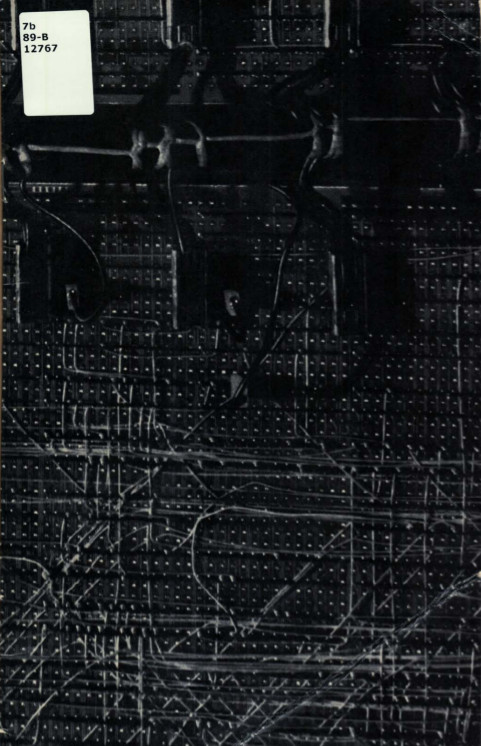Arte y Cibernética, catalogue (1970) [Spanish]
Filed under catalogue | Tags: · argentina, art, computer art, cybernetics, south america

A catalogue of the first computer art exhibition in Argentina, organised by Jorge Glusberg. With texts by Jasia Reichardt, Angel Kalenberg, Jorge Glusberg, Luis Osin, and Ricardo Ferraro.
Publisher Centro de Arte y Comunicacion (CAC), Buenos Aires, June 1970
via Pablo Colapinto
PDF (no OCR)
View discussion on cybernetics in Latin America (Yasmin mailing list)
Pamela M. Lee: Chronophobia: On Time in the Art of the 1960s (2004)
Filed under book | Tags: · art, art history, autopoiesis, kinetic art, systems theory, technology, time

“In the 1960s art fell out of time; both artists and critics lost their temporal bearings in response to what E. M. Cioran called “not being entitled to time.” This anxiety and uneasiness about time, which Pamela Lee calls “chronophobia,” cut across movements, media, and genres, and was figured in works ranging from kinetic sculptures to Andy Warhol films. Despite its pervasiveness, the subject of time and 1960s art has gone largely unexamined in historical accounts of the period. Chronophobia is the first critical attempt to define this obsession and analyze it in relation to art and technology.
Lee discusses the chronophobia of art relative to the emergence of the Information Age in postwar culture. The accompanying rapid technological transformations, including the advent of computers and automation processes, produced for many an acute sense of historical unknowing; the seemingly accelerated pace of life began to outstrip any attempts to make sense of the present. Lee sees the attitude of 1960s art to time as a historical prelude to our current fixation on time and speed within digital culture. Reflecting upon the 1960s cultural anxiety about temporality, she argues, helps us historicize our current relation to technology and time.
After an introductory framing of terms, Lee discusses such topics as “presentness” with respect to the interest in systems theory in 1960s art; kinetic sculpture and new forms of global media; the temporality of the body and the spatialization of the visual image in the paintings of Bridget Riley and the performance art of Carolee Schneemann; Robert Smithson’s interest in seriality and futurity, considered in light of his reading of George Kubler’s important work The Shape of Time: Remarks on the History of Things and Norbert Wiener’s discussion of cybernetics; and the endless belaboring of the present in sixties art, as seen in Warhol’s Empire and the work of On Kawara.”
Publisher MIT Press, 2004
ISBN 026212260X, 9780262122603
394 pages
PDF, PDF (updated on 2019-5-27)
Comments (2)Tiqqun: This Is Not a Program (2001/2011)
Filed under book | Tags: · biopolitics, capitalism, critique, critique of technology, cybernetics, resistance, surveillance

“Traditional lines of revolutionary struggle no longer hold. Rather, it is ubiquitous cybernetics, surveillance, and terror that create the illusion of difference within hegemony. Configurations of dissent and the rhetoric of revolution are merely the other face of capital, conforming identities to empty predicates, ensuring that even ‘thieves,’ ‘saboteurs,’ and ‘terrorists’ no longer exceed the totalizing space of Empire. This Is Not a Program offers two texts, both originally published in French by Tiqqun with Introduction to Civil War in 2001. In This Is Not a Program, Tiqqun outlines a new path for resistance and struggle in the age of Empire, one that eschews the worn-out example of France’s May ‘68 in favor of what they consider to be the still fruitful and contemporary insurrectionary movements in Italy of the 1970s. ‘As a Science of Apparatuses’ examines the way Empire has enforced on the subject a veritable metaphysics of isolation and pacification, “apparatuses” that include chairs, desks, computers; surveillance (security guards, cameras); disease (depression); crutch (cell phone, lover, sedative); and authority.
Tiqqun’s critique of the biopolitical subject and omnipresent Empire is all the more urgent as we become inured to the permanent state of exception that is the War on Terror and to other, no less intimate forms of pacification. But all is not lost. In its unrelenting production of the Same, Empire itself creates the conditions necessary for the insurrection to come.”
Originally published by Editions La Fabrique in 2009. Earlier published in issue 2 of Tiqqun (2001).
Translated by Joshua David Jordan
Publisher Semiotext(e), 2011
Intervention series, 7
ISBN 1584350970, 9781584350972
215 pages
PDF (updated on 2017-6-26)
Comment (1)
